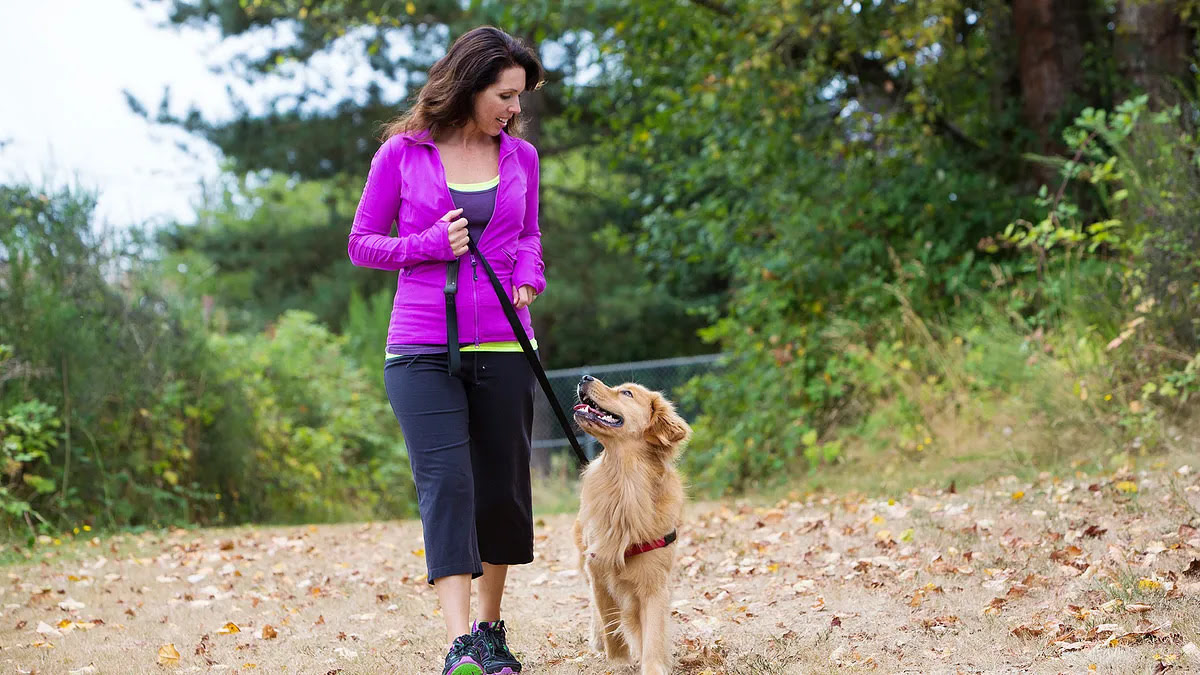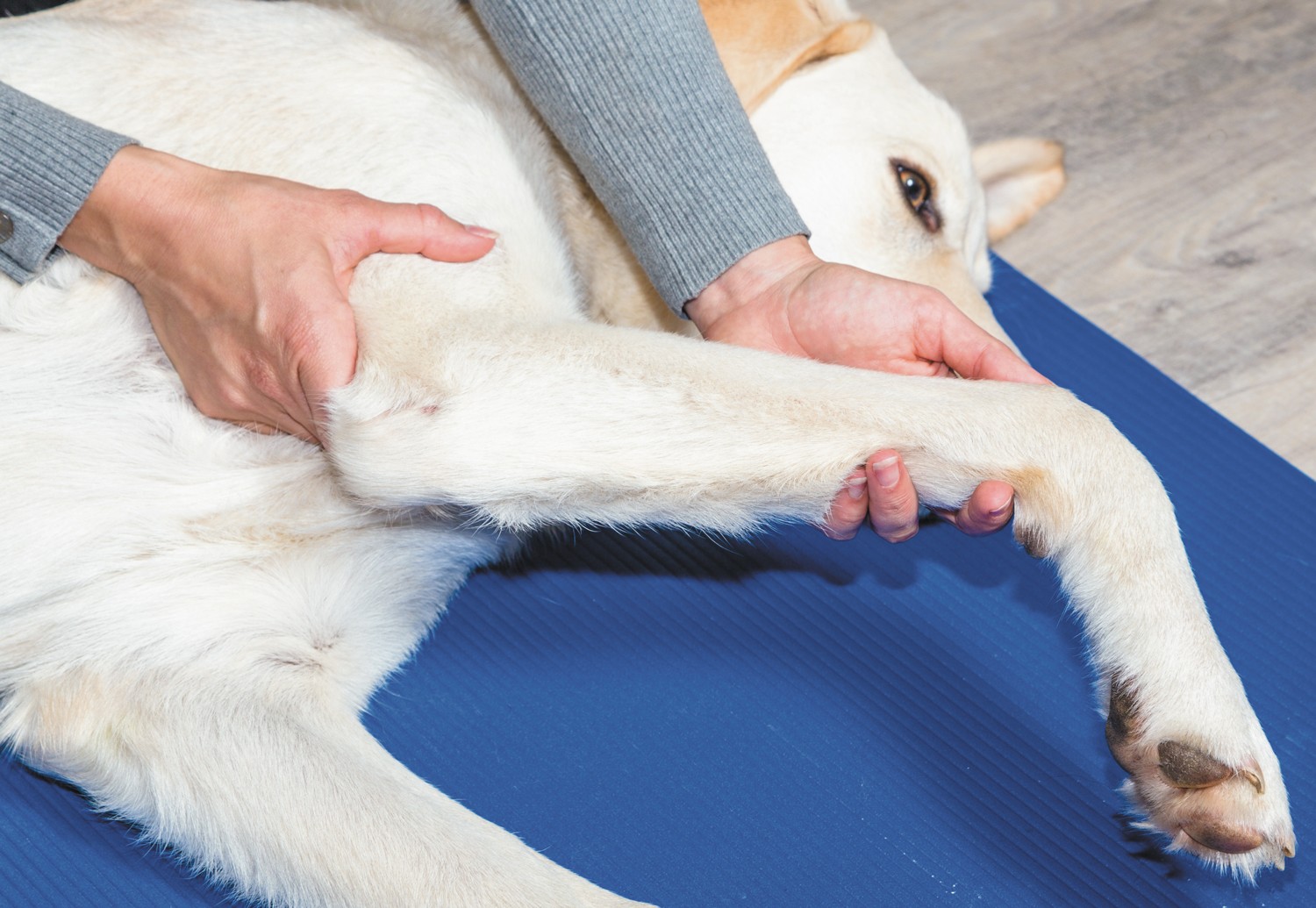Home>Health & Wellness>Common Health Issues>Muscular and Joint Health>Should You Walk A Dog Who Has Severe Arthritis


Muscular and Joint Health
Should You Walk A Dog Who Has Severe Arthritis
Modified: February 21, 2024
Discover the best practices for walking a dog with severe arthritis and promoting muscular and joint health. Learn how to support your pet's mobility and overall well-being.
(Many of the links in this article redirect to a specific reviewed product. Your purchase of these products through affiliate links helps to generate commission for Pawsomeoldies.com, at no extra cost. Learn more)
Table of Contents
Introduction
Welcoming a furry friend into your life brings immeasurable joy and companionship. Dogs, known for their unwavering loyalty and boundless energy, become cherished members of our families. However, as dogs age, they may encounter health challenges, including arthritis. This condition, characterized by joint inflammation, stiffness, and discomfort, can significantly impact a dog's quality of life.
As responsible pet owners, it's crucial to understand the implications of arthritis and how it affects our canine companions. Moreover, we must explore the best ways to support and care for them, ensuring their well-being and happiness. In this article, we delve into the topic of walking dogs with severe arthritis, shedding light on the benefits, risks, and alternative forms of exercise for our beloved pets.
Understanding the unique needs of dogs with arthritis is essential for providing them with the care and attention they deserve. By gaining insights into this condition and learning about suitable exercise options, we can make informed decisions that promote our dogs' physical health and emotional well-being. Let's embark on this journey of understanding and compassion, discovering the best ways to support dogs with severe arthritis in leading fulfilling lives.
Read more: Should I Shave My Dog Who Has Fleas?
Understanding Arthritis in Dogs
Arthritis, a common ailment in aging dogs, can significantly impact their mobility and overall comfort. This condition, also known as osteoarthritis or degenerative joint disease, affects the joints, leading to inflammation, pain, and stiffness. As dogs age, the cartilage that cushions their joints may deteriorate, causing the bones to rub against each other, resulting in discomfort and reduced mobility.
The signs of arthritis in dogs can be subtle initially, with symptoms such as reluctance to engage in physical activities, limping, difficulty standing up, and a noticeable decrease in overall activity levels. As the condition progresses, dogs may exhibit signs of pain, such as whimpering or yelping when touched in certain areas, and they may become less enthusiastic about walks or playtime.
It's important to note that arthritis can affect dogs of all breeds and sizes, although larger breeds and overweight dogs may be more susceptible due to the additional strain on their joints. Furthermore, certain factors, such as genetics, previous joint injuries, and underlying health conditions, can contribute to the development of arthritis in dogs.
To provide the best care for a dog with arthritis, it's essential to recognize the signs early and seek veterinary guidance. A veterinarian can conduct a thorough examination, including X-rays and joint fluid analysis, to diagnose arthritis and develop a tailored treatment plan.
Understanding the impact of arthritis on dogs is crucial for implementing appropriate measures to alleviate their discomfort and enhance their quality of life. By recognizing the signs of arthritis and seeking professional guidance, pet owners can take proactive steps to support their furry companions through this challenging condition.
The Importance of Exercise for Dogs with Arthritis
Regular exercise plays a pivotal role in maintaining the overall well-being of dogs, including those affected by arthritis. While it may seem counterintuitive to encourage physical activity for dogs with joint discomfort, appropriate exercise can offer a myriad of benefits for their physical and mental health.
Engaging in gentle, low-impact exercise routines can help dogs with arthritis maintain muscle strength and flexibility. These exercises can aid in supporting the affected joints, preventing muscle atrophy, and promoting better mobility. Additionally, regular physical activity can contribute to weight management, a crucial aspect of arthritis management in dogs. Maintaining a healthy weight reduces the strain on the joints, potentially alleviating discomfort and enhancing the dog's overall comfort.
Furthermore, exercise stimulates the production of synovial fluid within the joints, which acts as a natural lubricant, promoting smoother joint movement and potentially reducing stiffness. It also facilitates improved blood circulation, delivering essential nutrients to the joints and aiding in the removal of metabolic waste products, thereby supporting joint health.
Beyond the physical benefits, exercise can have a positive impact on a dog's mental well-being. It provides mental stimulation, alleviates boredom, and fosters a sense of fulfillment, contributing to a dog's overall happiness and quality of life. Additionally, regular exercise can help reduce stress and anxiety, promoting a more balanced emotional state for dogs coping with the challenges of arthritis.
It's important to note that the key to exercising a dog with arthritis lies in moderation and choosing activities that are gentle on the joints. Low-impact exercises such as swimming, leash walking, and controlled indoor play can be highly beneficial. These activities minimize stress on the joints while promoting muscle strength and cardiovascular health.
In essence, incorporating suitable exercise into the routine of a dog with arthritis can significantly enhance their physical and emotional well-being. By understanding the importance of tailored exercise regimens and implementing them thoughtfully, pet owners can play a pivotal role in supporting their furry companions through the management of arthritis, ultimately contributing to a better quality of life for their beloved pets.
Risks and Benefits of Walking a Dog with Severe Arthritis
Walking a dog with severe arthritis presents a unique set of risks and benefits that must be carefully considered to ensure the well-being of the canine companion. Understanding these factors is crucial for pet owners seeking to provide appropriate care and support for their furry friends.
Benefits of Walking
Walking, when approached thoughtfully, can offer several benefits for a dog with severe arthritis. It provides an opportunity for controlled, low-impact exercise, which is essential for maintaining muscle strength and joint flexibility. Additionally, walking can contribute to weight management, a critical aspect of arthritis management in dogs. By promoting a healthy weight, walking helps reduce the strain on the joints, potentially alleviating discomfort and enhancing the dog's overall comfort.
Furthermore, walking can stimulate the production of synovial fluid within the joints, acting as a natural lubricant that supports smoother joint movement and potentially reduces stiffness. It also facilitates improved blood circulation, delivering essential nutrients to the joints and aiding in the removal of metabolic waste products, thereby supporting joint health. From a mental perspective, walking provides valuable mental stimulation, alleviates boredom, and fosters a sense of fulfillment, contributing to the dog's overall happiness and quality of life.
Risks to Consider
While walking can offer numerous benefits, it's essential to be mindful of the potential risks associated with walking a dog with severe arthritis. Overexertion or engaging in high-impact activities can exacerbate joint discomfort and lead to increased inflammation. It's crucial to monitor the dog's behavior during and after walks, as signs of excessive fatigue or discomfort may indicate that the activity level needs to be adjusted.
Additionally, walking on uneven or hard surfaces can pose a risk to dogs with arthritis, potentially causing added strain on the joints and increasing the likelihood of injury. Pet owners should carefully select walking routes that offer gentle terrain and consider using supportive footwear or protective paw coverings to minimize the impact on the dog's joints.
Finding the Balance
Balancing the benefits and risks of walking a dog with severe arthritis requires a thoughtful and individualized approach. Consulting with a veterinarian to determine the most suitable exercise regimen for the specific needs of the dog is essential. By understanding the unique circumstances of the dog's condition and considering the potential benefits and risks, pet owners can make informed decisions regarding walking and other forms of exercise, ultimately contributing to the dog's comfort, mobility, and overall well-being.
In essence, while walking can offer valuable physical and mental benefits for dogs with severe arthritis, it's crucial to approach this activity with care and consideration, ensuring that it supports the dog's health and comfort without causing undue strain or discomfort. By striking a balance between the benefits and risks, pet owners can provide their furry companions with the opportunity to enjoy the positive aspects of walking while minimizing potential adverse effects on their arthritic joints.
Tips for Walking a Dog with Severe Arthritis
When walking a dog with severe arthritis, it's essential to approach this activity with careful consideration and attention to the specific needs of the canine companion. By implementing the following tips, pet owners can create a supportive and comfortable walking experience for their furry friends, promoting their physical well-being and overall quality of life.
-
Consult with a Veterinarian: Before initiating a walking routine for a dog with severe arthritis, it's crucial to seek guidance from a veterinarian. A professional assessment of the dog's condition can provide valuable insights into the most suitable exercise regimen, taking into account the severity of the arthritis, the dog's age, weight, and overall health.
-
Choose the Right Time and Duration: Opt for walking during the cooler parts of the day to minimize discomfort for the dog. Additionally, start with shorter walks and gradually increase the duration as the dog becomes more accustomed to the activity. Monitoring the dog's response during and after the walk is essential to gauge their comfort level and adjust the duration accordingly.
-
Select Suitable Walking Surfaces: When walking a dog with severe arthritis, it's important to choose walking routes with even and soft surfaces. Avoiding rough terrain and opting for grassy or padded paths can reduce the impact on the dog's joints, promoting a more comfortable walking experience.
-
Use Supportive Gear: Consider using a harness or a supportive dog harness to provide gentle assistance and stability during the walk. Additionally, protective paw coverings can offer added support and minimize the impact of walking on hard or uneven surfaces, enhancing the dog's comfort.
-
Monitor Signs of Discomfort: Pay close attention to the dog's body language and behavior during the walk. Signs of excessive fatigue, limping, or reluctance to continue may indicate discomfort and the need to adjust the walking pace or duration. Being attuned to the dog's cues is essential for ensuring a positive and comfortable walking experience.
-
Incorporate Rest Breaks: Integrate short rest breaks into the walking routine to allow the dog to recuperate and avoid overexertion. Providing access to shaded areas and water during breaks is crucial, especially in warmer weather, to ensure the dog remains comfortable and hydrated.
-
Consider Alternative Exercise Options: In addition to walking, explore alternative forms of low-impact exercise that can benefit a dog with severe arthritis. Swimming, controlled indoor play, and gentle stretching exercises can complement the walking routine, providing variety and promoting overall joint health.
By implementing these tips, pet owners can create a supportive and enjoyable walking experience for their dogs with severe arthritis. Thoughtful consideration of the dog's individual needs, combined with appropriate guidance from a veterinarian, can contribute to a walking routine that supports the dog's physical comfort, mobility, and overall well-being.
Alternative Forms of Exercise for Dogs with Severe Arthritis
In addition to walking, there are several alternative forms of exercise that can benefit dogs with severe arthritis. These low-impact activities provide opportunities for physical movement and mental stimulation while minimizing stress on the joints, making them valuable additions to the exercise regimen of arthritic dogs.
Swimming
Swimming is widely regarded as an excellent form of exercise for dogs with arthritis. The buoyancy of water reduces the impact on the joints while allowing for a full range of motion. This low-impact activity promotes muscle strength, cardiovascular health, and joint flexibility. Additionally, the resistance provided by water enhances muscle tone and can contribute to weight management, all while offering a refreshing and enjoyable experience for the dog.
Controlled Indoor Play
Engaging in controlled indoor play can provide dogs with arthritis with opportunities for physical activity in a safe and comfortable environment. Interactive toys, such as puzzle feeders or gentle tug-of-war games, can stimulate movement and mental engagement without placing excessive strain on the joints. This form of play encourages muscle use and joint mobility while catering to the dog's individual pace and comfort level.
Gentle Stretching Exercises
Incorporating gentle stretching exercises into the daily routine of a dog with severe arthritis can promote joint flexibility and muscle relaxation. These exercises, guided by a veterinarian or professional trainer, can help maintain range of motion in the affected joints and prevent stiffness. By carefully stretching the dog's limbs and gently massaging the muscles, pet owners can contribute to the dog's overall comfort and joint health.
Canine Massage Therapy
Massage therapy tailored for dogs with arthritis can offer a range of benefits, including pain relief, improved circulation, and reduced muscle tension. Professional canine massage therapists can employ specialized techniques to target areas of discomfort and promote relaxation. This form of therapy not only supports joint mobility but also provides emotional comfort and bonding between the dog and their caregiver.
By incorporating these alternative forms of exercise into the routine of a dog with severe arthritis, pet owners can provide a diverse and enriching approach to promoting their pet's physical and emotional well-being. Each activity offers unique benefits that contribute to the overall management of arthritis in dogs, fostering a supportive and enjoyable lifestyle for these beloved companions.
Conclusion
In conclusion, the well-being of dogs with severe arthritis hinges on a comprehensive understanding of their condition and the implementation of tailored care and exercise regimens. As responsible pet owners, it is our duty to prioritize the comfort, mobility, and overall quality of life of our furry companions, especially when they are navigating the challenges of arthritis.
Throughout this exploration, we have delved into the intricacies of arthritis in dogs, recognizing the impact it can have on their joints, mobility, and emotional well-being. By understanding the signs and implications of arthritis, pet owners can proactively seek veterinary guidance, leading to early diagnosis and the development of personalized treatment plans.
The importance of exercise for dogs with arthritis cannot be overstated. Thoughtfully designed exercise routines, including walking and alternative forms of low-impact activities, play a pivotal role in maintaining muscle strength, joint flexibility, and overall physical health. Furthermore, these activities contribute to weight management, joint lubrication, and mental stimulation, fostering a balanced and fulfilling lifestyle for dogs with arthritis.
When considering the risks and benefits of walking a dog with severe arthritis, it becomes evident that a mindful and individualized approach is essential. By balancing the potential advantages of walking with the need to minimize strain and discomfort, pet owners can create a supportive and enjoyable walking experience for their furry companions.
The tips provided for walking a dog with severe arthritis offer practical guidance for pet owners, emphasizing the significance of consulting with a veterinarian, choosing suitable walking surfaces, and monitoring the dog's comfort level. These considerations, combined with alternative exercise options such as swimming, controlled indoor play, and gentle stretching exercises, contribute to a holistic approach to supporting dogs with arthritis.
In essence, the journey of caring for a dog with severe arthritis is one that requires empathy, attentiveness, and a commitment to providing the best possible care. By embracing a multifaceted approach that encompasses veterinary guidance, tailored exercise regimens, and a deep understanding of the dog's individual needs, pet owners can make a profound difference in the lives of their arthritic companions.
As we navigate this path of compassion and dedication, we have the opportunity to enrich the lives of our beloved dogs, ensuring that they continue to experience joy, comfort, and a sense of belonging within our families. By championing their well-being and supporting them through the challenges of arthritis, we honor the unwavering loyalty and companionship they bring into our lives, fostering a bond that transcends words and endures through care and understanding.












